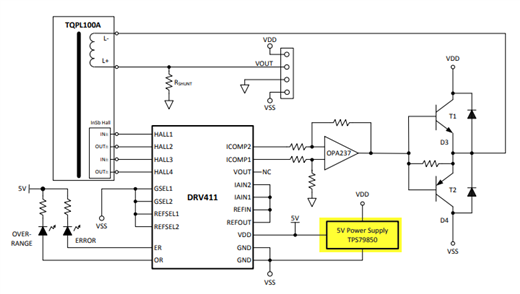Other Parts Discussed in Thread: DRV421, OPA454, OPA237, TIPD184
Tool/software:
Dear team,
I am referring to the TI design guide titled ±50A Current Sensor Using Closed-Loop Compensated Hall Element (www.ti.com/.../TIPD180) and have the following queries:
-
In the design, a 10 Ω shunt is used with the compensation coil, which is correct as per calculations. However, Appendix A mentions a parallel 1 kΩ resistor, making the total resistance approximately 9.901 Ω. Is this parallel network added solely for resistance correction?
-
Regarding the 7th point "modification "in the document:
To design a higher range closed-loop current sensor (±1500 A max), apart from adjusting the shunt resistor value and compensation coil turns/inductance, are there other factors to consider? Can the same PCB layout be used with just component value changes?Gain Selection:
The IC provides three configurable gain modes:- Gain 1: 250 V/V, frequency 3.8 kHz
- Gain 2: 250 V/V, frequency 7.2 kHz
- Gain 3: 1000 V/V, frequency 3.8 kHz
My doubts are:
- On what parameters should the suitable gain mode be selected? The guide suggests starting with Gain 3, but what specific observations or tests should be made?
- what this gain means what is there role with respect to the compensation coil?
- The document mentions inductance and core size as critical factors. Are there additional parameters to consider, particularly for determining the gain when designing a wire-wound core?
I would appreciate clarification on these points. Thank you!



